Hi,
I am using PGA450 for reverse distance sensing purpose in our automotive product.
I have PGA450-Q1 Evaluation board with me. it is communicated via pc GUI with LIN communication using following commands -
1. PID = 0x21
2. PID= 0x11; data = 0x00
3. PID = 0x22; receive databytes = 2;
This is the communication between PC GUI to single slave on EVM.
My Question -
For our application, we are using 4 sensor for reverse distance measurement, i have question that, How to send LIN commands (like mentioned above) to particular slave out of the four?
How to communicate with individual slave using LIN frames?
Please reply soon.





